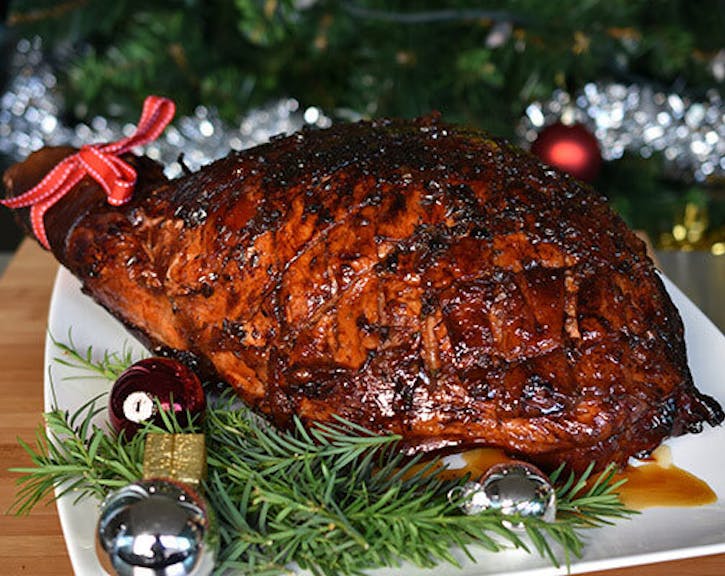Riesling and Red Currant Glazed Ham

Set up your kettle for indirect normal fire cooking method, using approximately 22 Weber Barbecue Briquettes in each charcoal basket. Light the fire-lighters and move the charcoal baskets to the center of the charcoal grate over the flames.
With a sharp knife, cut the rind around the sides of the pork, around the knuckle, and down the centre to free it on all sides, ensuring that you have cut right through the rind to the fat, but not into the flesh.
Approximately 25 to 30 minutes after lighting, all of the coals will be ashed over and ready for cooking. Separate the charcoal baskets using tongs. Place foil drip pans between the two fires (must be large enough to catch all of the drippings). Place the cooking grill on the barbecue with the grill handles directly over the fires.
Place the pork on to the cooking grill. If the edges of the pork are hanging over the direct zone (above the fire), shield the sides with aluminium foil. Close the lid, ensuring the air vents are open and positioned over the indirect zone. Cook for 2½ hours to blister the skin.
To make the glaze, combine the butter and shallots in a saucepan over high heat and cook until the shallots are cooked. Add the thyme, Riesling, red currant jelly, balsamic vinegar, and pepper. Continue to simmer for 10 to 15 minutes or until the glaze is thickened and caramelised, stirring often. Set aside to cool completely.
Remove the pork skin with tongs. Score the fat in a diamond pattern, being careful not to cut into the flesh, as the ham flesh will dry out.
Top up the charcoal baskets with additional barbecue briquettes. Add three wood chunks to the coals. Continue to cook the ham for a further 30 minutes to render the fat before applying the glaze.
After 30 minutes of the ham cooking without the skin, decorate with the whole cloves. Apply a generous amount of the glaze over the ham and continue cooking for a further 1 hour, glazing the ham every 20 minutes.
Once the ham has cooked and reached an internal temperature of 68°C, remove the ham from the barbecue. The internal temperature will continue to rise 3° to 6°C while it’s resting. Leave to rest for 15 minutes before carving.
Ingredients
Directions
Set up your kettle for indirect normal fire cooking method, using approximately 22 Weber Barbecue Briquettes in each charcoal basket. Light the fire-lighters and move the charcoal baskets to the center of the charcoal grate over the flames.
With a sharp knife, cut the rind around the sides of the pork, around the knuckle, and down the centre to free it on all sides, ensuring that you have cut right through the rind to the fat, but not into the flesh.
Approximately 25 to 30 minutes after lighting, all of the coals will be ashed over and ready for cooking. Separate the charcoal baskets using tongs. Place foil drip pans between the two fires (must be large enough to catch all of the drippings). Place the cooking grill on the barbecue with the grill handles directly over the fires.
Place the pork on to the cooking grill. If the edges of the pork are hanging over the direct zone (above the fire), shield the sides with aluminium foil. Close the lid, ensuring the air vents are open and positioned over the indirect zone. Cook for 2½ hours to blister the skin.
To make the glaze, combine the butter and shallots in a saucepan over high heat and cook until the shallots are cooked. Add the thyme, Riesling, red currant jelly, balsamic vinegar, and pepper. Continue to simmer for 10 to 15 minutes or until the glaze is thickened and caramelised, stirring often. Set aside to cool completely.
Remove the pork skin with tongs. Score the fat in a diamond pattern, being careful not to cut into the flesh, as the ham flesh will dry out.
Top up the charcoal baskets with additional barbecue briquettes. Add three wood chunks to the coals. Continue to cook the ham for a further 30 minutes to render the fat before applying the glaze.
After 30 minutes of the ham cooking without the skin, decorate with the whole cloves. Apply a generous amount of the glaze over the ham and continue cooking for a further 1 hour, glazing the ham every 20 minutes.
Once the ham has cooked and reached an internal temperature of 68°C, remove the ham from the barbecue. The internal temperature will continue to rise 3° to 6°C while it’s resting. Leave to rest for 15 minutes before carving.
